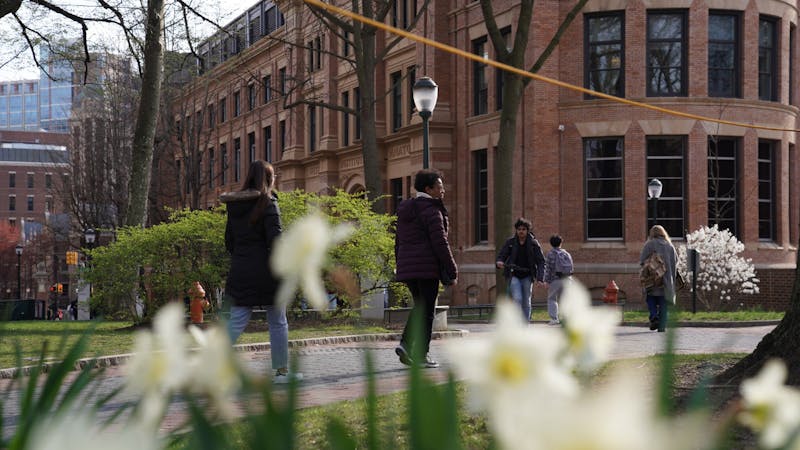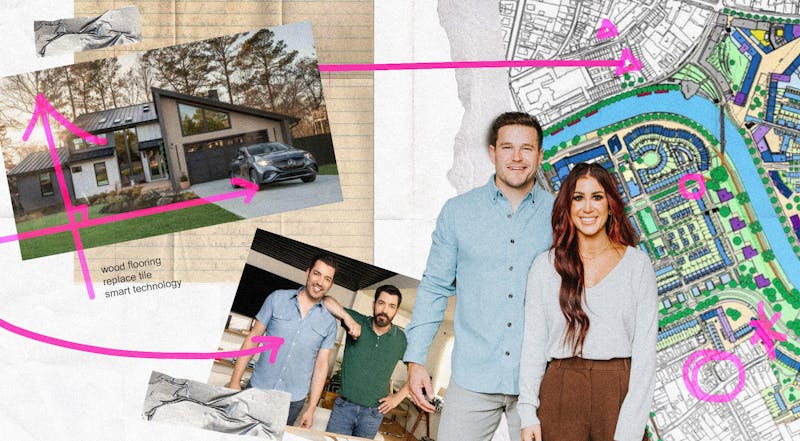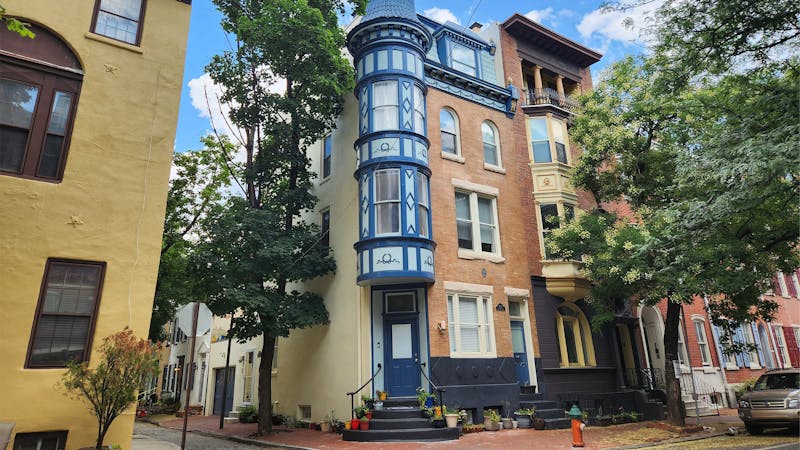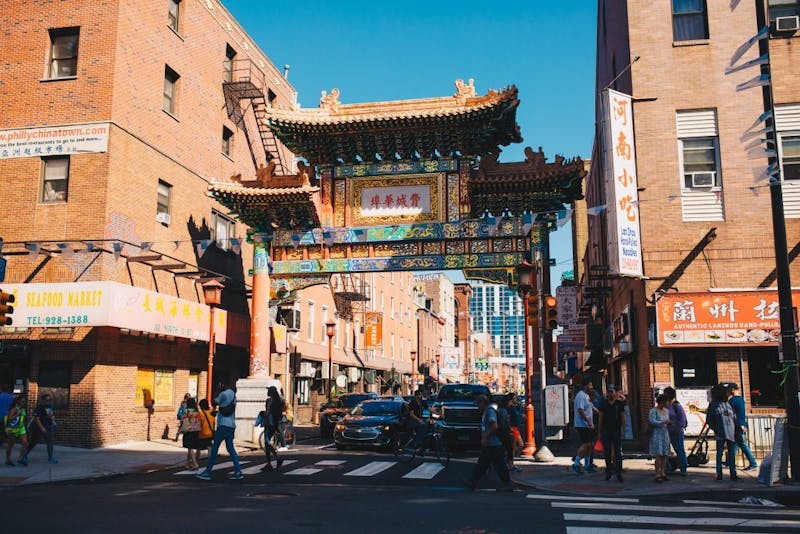Parallel to the rushing traffic of Arch Street is a large stage. A crowd gathers on the sidewalks packed tighter than a tin of sardines. Perpendicular to Arch on 10th Street, which has been temporarily shut down, sits rows of folding chairs. Not a single one is empty. All heads are turned towards the scene unfolding onstage. A woman gracefully dances with two swords. The background music is nearly inaudible over the racket of city noise, but a hushed silence hangs over the engaged audience.
The crowd of onlookers eventually simmers off, venturing into the rest of the festivities further down 10th Street. Booths line the sides of buildings, offering face painting, local art, printmaking instructions, and a mooncake eating contest. Young kids tug the hands of their parents towards the next craft, among small groups of adults conversing together and teens toting posters and boba. A cultural hub has planted itself in this street for the day. It is only when you look above to see vibrant, orange stoplights that the typical daily rush of cars on this street is remembered.
This is the 29th Annual Mid–Autumn Festival that Asian Americans United (AAU) has hosted in Philly’s Chinatown. A popular holiday stemming from ancient China, the festival has become an increasingly important cultural tradition for the Asian diaspora. Philadelphia's Chinatown’s own celebration began in 1996 with a rather unique start. “It was me, my husband, and a bunch of middle schoolers,” says Debbie Wei, community organizer and co–founder of AAU.
Wei had been working with kids within the Chinatown community as part of her work for AAU. “They were feeling very lost in being in the U.S. and being in what sometimes was very hostile environments. The kids were homesick around Mid–Autumn Festival, but one kid in particular said he felt bad for his grandparents.” These concerns grew into action, as Wei and the kids decided to host a festival for seniors.
“We thought maybe 50 or 60 people would come to this thing,” she says, “but 400 people came that night. That’s when we realized, we have to keep doing this thing.” The strong turnout from the first festival to its most current iteration is characteristic of the tight–knit community that inhabits the space. In fact, the found–home Chinatown offers has been a driving force behind the neighborhood since its inception
“Back in the day, this was land that no one else wanted, and this was a community that no one else wanted,” says Mohan Seshadri, executive director of the Asian Pacific Islander Political Alliance (API PA). He describes the anti–Asian violence many Chinese immigrants fled from in other areas of the country in the late 19th century. In 1871, for example, one of the largest mass lynchings was committed against Chinese immigrants in Los Angeles. “That’s one of the reasons why Philly’s Chinatown exists in the first place as a sanctuary from anti–Asian violence for our community. And that’s a role it serves not just for the Chinese community, but for so many other Asian American communities and immigrant communities in the last 150 years.”
The roots of Chinatown in Philadelphia began with a crop–up of small businesses. In 1870, Lee Fong opened a laundry service at 913 Race Street, which later also became a restaurant on the second floor. More restaurants, grocery stores, places of worship, childcare, and other needs for a self–sufficient community spiraled around Race Street. At the time, the area was perceived as Philly’s “red–light district,” or skid row. But despite the reputation of being undesirable and dangerous, 900 Race Street offered respite for the marginalized community.
The 913 Race Steet address has since been memorialized as the birthplace of Chinatown with a historical marker that reads, “Founded in the 1870s by Chinese immigrants, it is the only Chinatown in Pennsylvania. This unique neighborhood includes businesses and residences owned by and serving Chinese Americans. Here, Asian cultural traditions are preserved and ethnic identity perpetuated.”
The historical marker was fought for by the Philadelphia Chinatown Development Corporation (PCDC), an organization dedicated to economically uplifting and preserving Chinatown. This mission has manifested in a variety of ways, from assisting with affordable housing to youth programs. Most prominently, PCDC aids in fights against large development projects that threaten to destroy Chinatown businesses and displace its residents.
In 1966, PCDC formed as a response to the proposed Vine Street Expressway—which would demolish the Holy Redeemer Church, a central community space, and box Chinatown in with its exit ramps.
“Our founder, Cecilia Moy Yep, was a widow with young children. She read about the proposal, and saw her house […] was one of the buildings that would be demolished by the city government,” says Haoyi Shang, PCDC’s commercial corridor manager. Organized by Yep, a group of community members fought against the project, successfully saving the church and forming PCDC in the process.
But the Vine Street Expressway would still be built, effectively dividing Chinatown. In a form of personal protest, Yep refused to leave her home, telling the city she would only do so if they found her a comparable house for her to move to. Her home was the only one that remained standing in the area as other development projects tore down her neighbors.
22 years later, the government found a similarly sized house for Yep. Her home was destroyed the day after she moved out.
Following the contentious battle of the Vine Street Expressway, large development project proposals riddled the neighborhood, which the community organized against. Nearly every ten years a new project is proposed that will disrupt Chinatown: ‘64 Independence Mall IV; ‘66 Vine Street Expressway; ‘77 The Fashion District; ‘94 PA Convention Center; ‘94 Federal Prison; 2000 Phillies Baseball Stadium; 2008 Foxwoods Casino.
Some were losses for the community—the construction of the Convention Center displaced 200 people, but other hard–fought battles were won. The federal prison, which would’ve been next door to the Holy Redeemer Church was never built, nor the baseball stadium or the casino.
“The ones I remember were in 1993, there was a federal prison, in 2000 was the baseball stadium, in 2008 was a casino,” Wei recounts.
“Now we’re doing the arena right?” She laughs, exasperated.
In July 2022, the Sixers announced their $1.55 billion proposal to build a new arena between 10th and 11th streets near the southern border of Chinatown. In the following two years, a back–and–forth between concerned residents—both within Chinatown and in greater Philadelphia—and 76DevCo, their supporters, and the city government has consumed the city.
In response to the proposal, a coalition was created to oppose the arena. Seshadri says, “We were built by leaders who spent decades defending Chinatown from previous attacks, and that meant that once this thing kicked off two years ago, [API PA] were one of the organizations, alongside leaders and advocates in Chinatown itself, who formed the Save Chinatown Coalition to ensure that our voice was heard in this process of defending Chinatown and Center City against the existential threat the arena proposes.”
The Save Chinatown Coalition has since been joined by over 40 organizations alongside API PA, including PCDC and AAU. On Sept. 7, the coalition organized a march in Center City, from City Hall to Chinatown. Four days later, Mayor Cherelle Parker held a town hall to discuss the proposal in an effort to hear the concerns of those in Chinatown. The room was so packed, that two overflow rooms had to be established.
“We’ve had incredible support from people around mass actions. It was around 4,000 people that came to that march, even in the pouring rain,” Wei says. “When the mayor was jerking us around and saying, you know, ‘I’m gonna have a meeting in 72 hours,’ we were able to turn out 800 people in 72 hours for that meeting.”
Only a week after the Sept. 11 town hall, Parker announced via video on X, formerly known as Twitter, that she was endorsing the arena after reaching an agreement with the Sixers. She describes it as, “a historic agreement. It is the best financial deal ever entered into by a Philadelphia mayor for a local sports arena. I wholeheartedly believe it is the right deal for the people of Philadelphia.”
Parker’s endorsement isn’t the end of the road. Legislation to start construction must still be voted on and passed in City Council. As the city waits with bated breath, Chinatown organizers and advocates continue onward in their never–ending battle.
“If you look at the history of Chinatown, especially the recent history of Chinatown, you will see there’s a history of fighting and resistance. The 76ers proposal is not nothing new, because we had the same fight 20 years ago against the baseball stadium. But definitely different player, different stakeholder,” Shang says.
Shang points out the essential difference between fighting against the Sixers arena versus previous government projects: private money.
The Sixers arena proposal is backed by David Adelman, chairman of 76 Place and CEO of Campus Apartments, Josh Harris, co–managing partner of Sixers and co–founder of private equity firm Apollo Global Management, and David Blitzer, co–managing partner of Sixers and Global Head of Tactical Opportunities at the private equity firm Blackstone—all three of which are billionaires.
“They have more money than God,” Wei says. “This fight has been a lot harder because we’ve dealing with a very different type of developer. They’re pretty ruthless, and they’ve done this all over the globe. So when people hear who we’re up against, they’re like, ‘Oh, you can’t win this.’ And we’re like, ‘yes we can.’”
The fight is a worthy one, and a necessary one, because the Sixers arena poses a death threat to Chinatown. According to the Community Impact Analysis conducted by the Philadelphia City Planning Commission, the arena will cause the “loss of cultural identity in Chinatown.” Gentrification is one major issue that threatens the neighborhood, there is a potential risk for the displacement of low–income residents with rising property values.
The evaluation of the traffic situation is particularly bleak. Gridlock will occur if more than 40% of people drive to the arena for an event. Currently, 75% of fans drive to the Wells Fargo Center. Ensuing gridlock presents more than just an annoyance for those on the road, it puts people’s health at risk. Ambulances attempting to get to the Thomas Jefferson University Hospital, the only level 1 trauma center in Center City, may face longer drive times, a dangerous situation when every minute counts.
Small businesses in Chinatown are put in a difficult situation. The impact study states one in five businesses may see economic gain; these businesses are ones that appeal to outsiders of the community, like hotels and restaurants. However, half are likely to suffer negatively, particularly those critical to the community like grocery stores, banks, and healthcare. “All these things will kill Chinatown, right,” Wei says, “Because Chinatown exists because of its small businesses.”
Chinatown falls into the district of Councilmember Mark Squilla, who, following Parker’s endorsement, will introduce the necessary legislation to the City Council. The earliest date the legislation can appear is Oct. 24. Squilla promised the public 30 days to look over and raise concerns about what is being proposed.
“We believe that we have an opportunity to look at the CBA (Community Benefits Agreement) and see what concerns were not met as part of the legislation or the CBA, what needs to be changed or added before introduction,” says Squilla.
When asked about traffic concerns, he states, “There’s a lot of stakeholders that have the same common goal here to make sure that the transit plan works. And you know, we’re working with our partners in public transit … working with the arena folks, and the City Office of Transportation and systems, putting that plan together to make sure that it reaches the goals necessary to make it a viable arena location.”
Squilla discusses mitigating gentrification through two main solutions—a Tax Incremental Financial Plan to offset increasing property value and size–based restrictions on new businesses to indirectly support small businesses.
Alongside the legislation that will be introduced to the City Council, Parker’s negotiation with the Sixers includes a Community Benefits Agreement. The CBA promises $50 million over the span of 30 years with $25 million allotted for programs in the most–affected neighborhoods, and the other half going toward the city.
“$50 million over 30 years sounds like a big number, but it is a drop in the bucket compared to both what these billionaire developers stand to profit off of this initiative, as well as what the Chinatown community could possibly need in order to survive,” Seshadri says. Only $6.35 million of the money will go to Chinatown over the span of three decades.
The money, or lack thereof, is a slap in the face of the neighborhood that will be most impacted by the arena. The Chinatown community has consciously chosen to not sign off on the CBA, metaphorically rendering it null. But the legality of the agreement remains murky. “The one thing we do like to point out is that there is not a single organization, Asian organization, in this city has signed a community benefit agreement,” Wei says, “And CBAs are supposed to be between the developer and the communities most impacted by a project, which obviously was Chinatown, and the gayborhood, neither of which has signed CBAs.”
Though a better CBA and more government intervention may be able to slow down some of the negative impacts the Sixers arena will have, there is no denying that, ultimately, the arena poses an “existential threat” to Chinatown. Wei puts it bluntly: “No amount of money can stop Chinatown from being destroyed by this project.”
Oct. 24, the day legislation will be introduced to City Council, is quickly approaching. As such, the stakes feel even higher, as Chinatown residents, supporters, and all those against the arena are in a constant battle to make their voices heard.
Though he will introduce the legislation, Squilla has yet to make an official statement on which way he will vote. “We are still meeting with community stakeholders on what [the additions to CBA] are and what the arena people are willing to do, and that will really decide whether I support the legislation or not,” he says. Squilla did not provide specifics on what additional support in the CBA may look like, but he does establish that he still could vote either way on the legislation.
The project’s timeline feels rushed. 76DevCo’s construction timeline relies on legislation being passed by the end of this year and Parker endorsed the project less than a month after the 4, multi–hundred page Impact Studies were released. It has left many feeling that integral questions are unanswered.
“How much money is actually going to the school district? How much of a tax break is this actually for the developers? How is SEPTA actually going to handle this? ” Seshadri asks. He urges elected officials to slow the process and to allow these many questions to have satisfactory answers before moving forward.
Wei shares a similar sentiment, emphasizing that elected officials have not done their due diligence before they can knowledgeable vote on the topic. This issue expands beyond Chinatown as a neighborhood and brings into question the responsibility that city government has to its residents. “The city should be outraged,” Wei says, “Septa is dying, schools are being closed, kids can’t go to school, the temperatures are over 80 degrees, and the Sixers are offering tickets to basketball games for students? I think this has become symbolic of everything that’s wrong with politics in this city, and people see it and are angry and are getting ready to throw down with Chinatown.”
Legislation will most likely appear before City Council on Oct. 24. With 18 City Council members, a vote of nine is needed to either pass or fail the 11 necessary bills that will allow the arena proposal to move forward. Councilmembers Jeffrey Young Jr., Kendra Books, and Nicolas O’Rourke have come out as staunchly opposed to the arena. Councilmember Jim Harrity is the only one who has made a supportive stance. The other 13 members, including Squilla, have yet to declare either way.
Now, the efforts of Save Chinatown Coalition are urging all Philadelphians opposed to the arena to voice their concerns, whether it be signing a petition, a 30–second phone call to City Council, or taking a trip to City Hall and meeting with respective council members. Chinatown wants everyone to be heard, and they will make Philadelphia’s City government listen.
“Answer the question, once and for all,” Seshadri poses, “Is Philadelphia for working families and immigrant communities who are struggling to get by, or is Philadelphia now a place that just gives handout after handout to billionaires and developers at the expense of working people in working–class communities?”
Chinatown has been fighting for its right to survive since its birth in 1870. Yet, 150 years later, the community remains stronger than ever. The Sixers Arena is only the most recent attempt to take advantage of and harm the ethnic enclave in a long line of attempts. Though this fight may be unlike the ones before, Chinatown is rising to meet the challenge.
“In former fights you saw evidence of this emerging group of Asian Americans who are willing to stand up and, but this time around … it's a whole new generation in terms of children being raised,” Wei says. She talks of her daughter, Kaia Chau, protesting the stadium and casino as a young child, and how she is now helping lead the youth to organize with Students for the Preservation of Chinatown and the Ginger Arts Center, both youth–run initiatives.
Chinatown is changing the terms of this fight with a hard–to–ignore social media campaign alongside traditional methods of mobilizing that they have been perfecting for decades.
At this year’s Mid–Autumn festival, the energy was palpable. Throughout the crowd, people donned shirts with various slogans invoking the current battle. Posters lined the brick walls and booths dedicated to informing all those with a minute to spare stand beside those of typical festival celebrations.
The most iconic of the designs you have undoubtedly seen across the city and on your Instagram feed. It is simple. Big, red, blocky text taunts “NO ARENA IN CHINATOWN,” but the word arena is different. It is a black slash across the page. Underneath is the word casino, and underneath that is the word stadium. These are the cards they have been dealt, but Chinatown will never fold.





